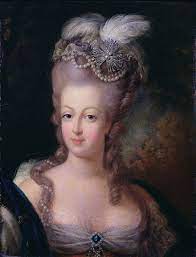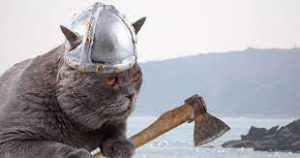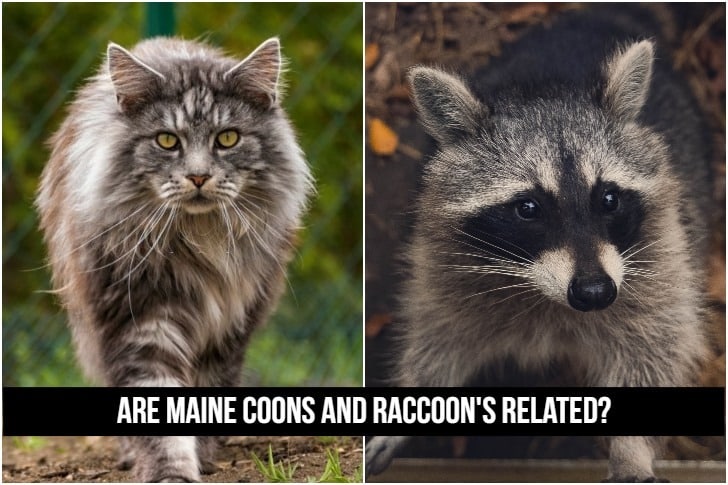[et_pb_section fb_built=”1″ _builder_version=”4.21.0″ _module_preset=”default” global_colors_info=”{}” theme_builder_area=”post_content”][et_pb_row _builder_version=”4.21.0″ _module_preset=”default” global_colors_info=”{}” theme_builder_area=”post_content”][et_pb_column type=”4_4″ _builder_version=”4.21.0″ _module_preset=”default” global_colors_info=”{}” theme_builder_area=”post_content”][et_pb_text _builder_version=”4.21.0″ _module_preset=”default” global_colors_info=”{}” theme_builder_area=”post_content”]
Maine Coons are one-of-a-kind felines that weigh up to 15 pounds more than their peers. Their size is impressive and are nicknamed gentle giants, but what really sets them apart are their ears – they look more like those of a lynx than of your average cat. These big cats are the largest domesticated cat breed found in America.
Their distinctive features have led to some wild speculation about their genetics and background. And here’s a fun fact: the “Coon” in their name has led people to believe Maine Coons are related to raccoons or are some type of cat-raccoon hybrids! But is that really the case? It’s time to look deeper into this common theory to definitively answer this heated question among cat lovers.
[/et_pb_text][/et_pb_column][/et_pb_row][et_pb_row _builder_version=”4.21.0″ _module_preset=”default” global_colors_info=”{}” theme_builder_area=”post_content”][et_pb_column type=”4_4″ _builder_version=”4.21.0″ _module_preset=”default” global_colors_info=”{}” theme_builder_area=”post_content”][et_pb_text _builder_version=”4.21.0″ _module_preset=”default” custom_margin=”||11px|||” global_colors_info=”{}” theme_builder_area=”post_content”]
Can Racoons and Cats Mate To Create Raccoon-Cat Hybrids?
[/et_pb_text][et_pb_image src=”https://petpackdaddy.com/wp-content/uploads/2023/06/Cute-Raccoon-Standing-On-A-Fallen-Tree_Reduced-Size.jpg” alt=”Cute Raccoon Standing On A Fallen Tree” title_text=”Cute Raccoon Standing On A Fallen Tree_Reduced Size” align=”center” _builder_version=”4.21.0″ _module_preset=”default” module_alignment=”left” max_height=”400px” global_colors_info=”{}” theme_builder_area=”post_content”][/et_pb_image][et_pb_text _builder_version=”4.21.0″ _module_preset=”default” custom_padding=”0px|||||” global_colors_info=”{}” theme_builder_area=”post_content”]
To set the record straight, Maine Coons are NOT part-raccoon. They’re a purebred cat breed with their own unique characteristics. However, it’s easy to see why some people might assume they have raccoon ancestry. Their large size, bushy tails, and fluffy fur all share similarities with that of raccoons.
In reality, Maine Coons are most likely descendants of Norwegian Forest cats. The Vikings, who sailed to America centuries ago, brought their beloved cats on board to help control the rat population on their European ships. These cats then interbred with local feral cats, eventually leading to the development of what we now know as the Maine Coon.
Although raccoons and cats may share physical characteristics, they’re entirely different species and cannot interbreed. While it’s true that cats and raccoons may try to mate, they cannot reproduce due to a genetic barrier. And even if they could, it’s unlikely that any offspring would survive. Raccoons are notorious predators and have been known to kill cats and their kittens, especially if approached by cats.
In fact, the idea of Maine Coons having raccoon ancestry is nothing more than a fable. This story likely originated from a misinterpretation of their physical similarities with raccoons. However, there’s no evidence to support this wild claim, and it’s safe to say that Maine Coons are 100% feline.
Maine Coons have unique features that set them apart from other cat breeds. For instance, they’re large cats known for their extra-large paws that give them a more substantial grip on slippery surfaces and make them excellent climbers. Their ears are also notable, being tufted at the tips and broad at the base, giving them a lynx-like appearance. They’re long-haired cats and come in a range of colors and patterns.
[/et_pb_text][/et_pb_column][/et_pb_row][et_pb_row _builder_version=”4.21.0″ _module_preset=”default” global_colors_info=”{}” theme_builder_area=”post_content”][et_pb_column type=”4_4″ _builder_version=”4.21.0″ _module_preset=”default” global_colors_info=”{}” theme_builder_area=”post_content”][et_pb_text _builder_version=”4.21.0″ _module_preset=”default” custom_margin=”||11px|||” global_colors_info=”{}” theme_builder_area=”post_content”]
Why Cats And Raccoons Cannot Interbreed
[/et_pb_text][et_pb_text _builder_version=”4.21.0″ _module_preset=”default” custom_padding=”0px|||||” global_colors_info=”{}” theme_builder_area=”post_content”]
Raccoons and cats belong to the same kingdom (Animalia), phylum (Chordata), class (Mammalia), and order (Carnivora) but not the same family, genera, or species. While raccoons belong to the Procyonidae family and Procyon genera, cats belong to the Felidae family and Felis genera. These distinct genetic differences explain why these animals look and behave differently from each other.
One of the most remarkable similarities between raccoons and cats is their reproductive anatomy. Both sexes have two testes/ovaries and a penis/vagina, making them physically capable of mating and producing offspring. So theoretically, female cats could mate with male raccoons or vice versa. However, raccoons and cats are reproductively isolated because they cannot fertilize each other’s eggs. This reproductive barrier is due to their genetic differences, which prevent their genetic material from combining successfully preventing the fertilization of eggs.
In contrast, donkeys and horses can reproduce because they have the same number of chromosomes, but the hybrid offspring (mules) are sterile. This reproductive disadvantage occurs because donkeys and horses have different genetic material and cannot produce viable gametes. Similarly, Maine Coon cats and raccoons cannot breed because their chromosomes are too different, and any potential hybrid offspring like the Maine Coon would be infertile.
Maine Coons cats are a breed of cats that originated in North America and are known for their grand size and affectionate personality. However, their origin story is often associated with raccoons due to their fur patterns and raccoon-like tail. While this is a myth, Maine Coons and raccoons share some physical characteristics, such as large ears, round eyes, and fluffy tails. Despite these similarities, Maine Coons are purebred cats that can have kittens and are not a cross between raccoons and cats. Raccoons are just different types of wild animals.
[/et_pb_text][/et_pb_column][/et_pb_row][et_pb_row _builder_version=”4.21.0″ _module_preset=”default” global_colors_info=”{}” theme_builder_area=”post_content”][et_pb_column type=”4_4″ _builder_version=”4.21.0″ _module_preset=”default” global_colors_info=”{}” theme_builder_area=”post_content”][et_pb_text _builder_version=”4.21.0″ _module_preset=”default” custom_margin=”||11px|||” global_colors_info=”{}” theme_builder_area=”post_content”]
The Origin Of The Maine Coon Cat Breed – Are They The Official State Cat Of Maine?
[/et_pb_text][et_pb_image src=”https://petpackdaddy.com/wp-content/uploads/2023/06/Grey-Maine-Coon-Cat-Sitting-On-A-Wooden-Plank_Reduced-Size.jpg” title_text=”Grey Maine Coon Cat Sitting On A Wooden Plank_Reduced Size” align=”center” _builder_version=”4.21.0″ _module_preset=”default” max_height=”400px” global_colors_info=”{}” theme_builder_area=”post_content”][/et_pb_image][et_pb_text _builder_version=”4.21.0″ _module_preset=”default” custom_padding=”0px|||||” global_colors_info=”{}” theme_builder_area=”post_content”]
The Maine Coon is indeed the official state cat of the state of Maine, also known as the pine tree state. Maine Coon cats are also known for their big and bushy tails, which sometimes resemble a raccoon’s tail, leading to the myth that they are a product of raccoon-cat breeding. But the origins of the maine coon cat are quite different, as scientists assure us that there is no physical evidence to back up this theory. Instead, they believe that Maine Coons originated from domesticated cats brought to North America by early settlers, who bred with local wild cats like bobcats and lynx.
While Maine Coons might not be a product of raccoon breeding, their similarity in coloring and tail can be attributed to the evolutionary phenomenon called convergent evolution. Convergent evolution is when unrelated species develop similar physical attributes to adapt to environmental conditions. In this case, the long tail of the Maine Coon helps them balance on tree branches, while their fur provides warmth during the cold winter months.
Maine Coon cats are also notably good swimmers, which is unusual for domesticated cats. This is yet another trait that might have developed due to their evolutionary roots, as cats in North America had to swim across rivers and lakes to hunt for prey. Some Maine Coon cats even enjoy swimming as a form of exercise!
Although Maine Coons might not have raccoon heritage, they do share some physical characteristics with bobcats and lynx. Unlike these wild cats, however, Maine Coons are a domesticated breed. They are known for their distinct personality, friendly and sociable nature, and playful and energetic temperament.
[/et_pb_text][/et_pb_column][/et_pb_row][et_pb_row _builder_version=”4.21.0″ _module_preset=”default” global_colors_info=”{}” theme_builder_area=”post_content”][et_pb_column type=”4_4″ _builder_version=”4.21.0″ _module_preset=”default” global_colors_info=”{}” theme_builder_area=”post_content”][et_pb_text _builder_version=”4.21.0″ _module_preset=”default” custom_margin=”||11px|||” global_colors_info=”{}” theme_builder_area=”post_content”]
The Ships Docking In Maine Theory
[/et_pb_text][et_pb_text _builder_version=”4.21.0″ _module_preset=”default” custom_padding=”0px|||||” global_colors_info=”{}” theme_builder_area=”post_content”]
There are several theories about how early maine coons came to be, but the most popular one suggests that Maine Coon cats originated in Maine around the 1800s. Some say that the breed was created by ship Captain Charles Coon, a seafarer who sailed off the coast of Maine. Captain Charles is rumored to have bred long hair and short-haired domestic cats to create the Maine Coon breed.
But why did Maine Coon cats become so popular in Maine specifically? One possible reason is that they were well-adapted to Maine’s harsh winters. Maine Coon cats have thick coats that keep them warm during cold weather, which would have been advantageous in the snow-covered state. Moreover, their large size and hunting skills made them excellent mousers, which was important in the days before pest control.
[/et_pb_text][/et_pb_column][/et_pb_row][et_pb_row _builder_version=”4.21.0″ _module_preset=”default” global_colors_info=”{}” theme_builder_area=”post_content”][et_pb_column type=”4_4″ _builder_version=”4.21.0″ _module_preset=”default” global_colors_info=”{}” theme_builder_area=”post_content”][et_pb_text _builder_version=”4.21.0″ _module_preset=”default” custom_margin=”||11px|||” global_colors_info=”{}” theme_builder_area=”post_content”]
The Marie Antoinette Theory
[/et_pb_text][et_pb_text _builder_version=”4.21.0″ _module_preset=”default” custom_padding=”0px|||||” hover_enabled=”0″ global_colors_info=”{}” theme_builder_area=”post_content” sticky_enabled=”0″]
Another popular theory has to do with Marie Antoinette, dating back to the French Revolution. In the late 18th century, during the Revolution, the famous queen Marie Antoinette tried to flee France with her family. She sent her beloved Turkish Angora cats to Maine in the New England regions of the United States in anticipation of her escape, but sadly, she could not follow. And legend has it that while Marie Antoinette may not have made it to safety, her cats did, and they became the founding ancestors of the Maine Coon breed. 
Marie Antoinette loved cats and brought many of them with her to France from her native Austria. Among them were several Turkish Angoras, which are known for their long, silky coats and striking blue or green eyes. These cats were highly valued and considered a status symbol during the queen’s reign. But as the French Revolution raged on, Marie Antoinette’s position became increasingly precarious, and she started planning her escape.
In 1793, she arranged to send her cats to her friend, Captain Samuel Clough, who lived in Wiscasset, Maine. The cats were loaded into a ship and crossed the Atlantic Ocean, eventually arriving in the United States. However, Marie Antoinette was arrested before she could make her way to safety, and she was later executed by guillotine.
Meanwhile, in Maine, the cats settled into their new home. They were free to roam and mate with other cats in the area, creating a unique hybrid breed that became known as the Maine Coon. While there is no definitive proof that the Maine Coon is descended from Marie Antoinette’s cats, it’s widely believed that they played a significant role in the breed’s early development.
[/et_pb_text][/et_pb_column][/et_pb_row][et_pb_row _builder_version=”4.21.0″ _module_preset=”default” global_colors_info=”{}” theme_builder_area=”post_content”][et_pb_column type=”4_4″ _builder_version=”4.21.0″ _module_preset=”default” global_colors_info=”{}” theme_builder_area=”post_content”][et_pb_text _builder_version=”4.21.0″ _module_preset=”default” custom_margin=”||11px|||” global_colors_info=”{}” theme_builder_area=”post_content”]
Maine Coons Are The Direct Descendents Of Viking Cats Theory
[/et_pb_text][et_pb_text _builder_version=”4.21.0″ _module_preset=”default” custom_padding=”0px|||||” hover_enabled=”0″ global_colors_info=”{}” theme_builder_area=”post_content” sticky_enabled=”0″]
According to Norse mythology, Skogkatt (Norwegian Forest Cat) was the cat that pulled the chariot of the goddess Freyja. They were also known for their hunting skills and were highly valued by farmers and sailors as they could ward off rodents on ships and farms.
During the Viking Age, Norwegian Forest cats were said to have traveled with Vikings on their voyages across the seas. However, there is no concrete evidence to support this claim. But, it is widely believed that Norwegian Forest cats sailed with Viking warriors to protect them from rodents, which could contaminate their food and water supplies. 
Theories suggest that Vikings brought their cats along when they sailed to North America. However, no definitive evidence exists that Vikings ever settled in North America. But, one interesting theory suggests that Viking’s Norwegian Forest cats might have mated with local cats, which later produced Maine Coons.
People believe that Norwegian Forest cats and Maine Coons are related due to their similar physical appearance. Both are large, fluffy, and affectionate cats with strong hunting instincts. However, it is tough to prove this theory as the origins of Maine Coons are unknown. Still, it’s fascinating to think about the possibility that these two cat breeds might be linked to some of the most intriguing stories in history.
If you see a Norwegian Forest cat, you might imagine it sailing the seas with Viking warriors. Or, if you come across a Maine Coon, you might wonder if it’s a descendant of Viking cats. Regardless of their origins, both breeds are majestic and adorable and deserve a special place in our hearts.
[/et_pb_text][/et_pb_column][/et_pb_row][et_pb_row _builder_version=”4.21.0″ _module_preset=”default” global_colors_info=”{}” theme_builder_area=”post_content”][et_pb_column type=”4_4″ _builder_version=”4.21.0″ _module_preset=”default” global_colors_info=”{}” theme_builder_area=”post_content”][et_pb_text _builder_version=”4.21.0″ _module_preset=”default” custom_margin=”||11px|||” global_colors_info=”{}” theme_builder_area=”post_content”]
Distinct Differences Between Males And Female Maine Coon Cats
[/et_pb_text][et_pb_text _builder_version=”4.21.0″ _module_preset=”default” custom_padding=”0px|||||” hover_enabled=”0″ global_colors_info=”{}” theme_builder_area=”post_content” sticky_enabled=”0″]
One of the most significant differences between male and female Maine Coon cats is their size. Male Maine Coons are generally larger than females. They can weigh between 13 to 18 pounds and stand up to 10-16 inches tall. On the other hand, female Maine Coons can weigh between 8 to 12 pounds and stand 8-14 inches tall. Although the size difference is typical, it’s essential to remember that each cat is different, and some females can weigh more than males.
Aside from their size difference, female Maine Coons have rounder heads and large, wide-set ears that make them look more feminine. Males, on the other hand, have larger heads and their ears appear slightly smaller, giving them a more masculine look. Additionally, female Maine Coons’ coats tend to be softer and silkier than males, which have a rough and more shaggy coat.
Maine Coons are known for their large, furry paws with tufted toes. They are polydactyl, which means they have extra toes, and their paws are more significant than most cat breeds. Their paws are also webbed, which makes them excellent swimmers. This unique feature makes Maine Coons an excellent pet for families living near water, as they can quickly get out of the water without any risk of drowning.
Maine Coons come in a variety of colors and have medium to long fur with a dense undercoat. Their smooth and shiny coats require minimal grooming, but they still benefit from occasional brushing as it helps to reduce shedding. Their long, large bushy tails help keep them warm and make them look majestic. They use their tails to communicate their moods and intentions, and their fluffy tails are the breed’s unique and defining feature.
[/et_pb_text][/et_pb_column][/et_pb_row][et_pb_row _builder_version=”4.21.0″ _module_preset=”default” global_colors_info=”{}” theme_builder_area=”post_content”][et_pb_column type=”4_4″ _builder_version=”4.21.0″ _module_preset=”default” global_colors_info=”{}” theme_builder_area=”post_content”][et_pb_text _builder_version=”4.21.0″ _module_preset=”default” custom_margin=”||11px|||” global_colors_info=”{}” theme_builder_area=”post_content”]
Maine Coons General Care Information
[/et_pb_text][et_pb_text _builder_version=”4.21.0″ _module_preset=”default” custom_padding=”0px|||||” global_colors_info=”{}” theme_builder_area=”post_content”]
Maine Coons are one of the coolest breeds when it comes to taking care of their long, thick fur. Not only do you get to enjoy their naturally stylish look, but a quick weekly brushing will also help prevent fur from spreading all over your home (yay, no more daily vacuuming!).
They’re truly a beautiful cat to own. Their fur is so unique that it can’t even be groomed, but it’s so thick that you could even shave it, and they’d still look mighty majestic.
And get this – Maine Coons are also pretty chill pets to care for. They don’t require much maintenance, are usually healthy, have plenty of energy, and get along smoothly with other animal companions. Pretty neat, huh?
[/et_pb_text][/et_pb_column][/et_pb_row][et_pb_row _builder_version=”4.21.0″ _module_preset=”default” global_colors_info=”{}” theme_builder_area=”post_content”][et_pb_column type=”4_4″ _builder_version=”4.21.0″ _module_preset=”default” global_colors_info=”{}” theme_builder_area=”post_content”][et_pb_text _builder_version=”4.21.0″ _module_preset=”default” custom_margin=”||11px|||” global_colors_info=”{}” theme_builder_area=”post_content”]
Maine Coons Cat Health Issues
[/et_pb_text][et_pb_text _builder_version=”4.21.0″ _module_preset=”default” custom_padding=”0px|||||” global_colors_info=”{}” theme_builder_area=”post_content”]
Maine Coons are commonly healthy, but there are a couple of issues to be aware of. Maine Coon cats aren’t more susceptible to health problems than other cats, but they have a greater chance of experiencing feline hypertrophic cardiomyopathy and hip dysplasia, which could lead to arthritis and lameness.
And, drumroll, please: Did you know that, on average, Maine Coon cats live to be about 12-14 years old? With proper breed selection, the health as mentioned above issues can be eliminated.
[/et_pb_text][/et_pb_column][/et_pb_row][et_pb_row _builder_version=”4.21.0″ _module_preset=”default” global_colors_info=”{}” theme_builder_area=”post_content”][et_pb_column type=”4_4″ _builder_version=”4.21.0″ _module_preset=”default” global_colors_info=”{}” theme_builder_area=”post_content”][et_pb_text _builder_version=”4.21.0″ _module_preset=”default” custom_margin=”||11px|||” global_colors_info=”{}” theme_builder_area=”post_content”]
Are Maine Coons Affordable To Adopt Or Purchase?
[/et_pb_text][et_pb_text _builder_version=”4.21.0″ _module_preset=”default” custom_padding=”0px|||||” global_colors_info=”{}” theme_builder_area=”post_content”]
Investing in a Maine Coon cat is an investment in your family, but don’t worry, it’s worth it! To avoid health issues, you gotta find a reputable breeder.
Prices? Well, they range from around $1,000 to $3,000 or more, depending on the features and quality of their bloodline. Yeah, they’re expensive, but hey, good things in life always are.
[/et_pb_text][/et_pb_column][/et_pb_row][et_pb_row _builder_version=”4.21.0″ _module_preset=”default” global_colors_info=”{}” theme_builder_area=”post_content”][et_pb_column type=”4_4″ _builder_version=”4.21.0″ _module_preset=”default” global_colors_info=”{}” theme_builder_area=”post_content”][et_pb_text _builder_version=”4.21.0″ _module_preset=”default” custom_margin=”||11px|||” global_colors_info=”{}” theme_builder_area=”post_content”]
Would Maine Coons Be An Ideal Cat Choice?
[/et_pb_text][et_pb_text _builder_version=”4.21.0″ _module_preset=”default” custom_padding=”0px|||||” global_colors_info=”{}” theme_builder_area=”post_content”]
If you’re looking for a fantastic new furball friend, the Maine Coon Cat is a great choice! These hearty and friendly fuzzballs are ideal for families with allergies (though not hypoallergenic) and require very little maintenance.
[/et_pb_text][/et_pb_column][/et_pb_row][/et_pb_section]

Leave a Reply
You must be logged in to post a comment.